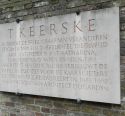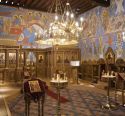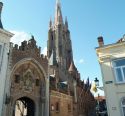Religious heritage in Bruges: walk with the precursors of the faith!
Together with the deanery of Bruges, Open Churches released a brochure describing a walk through Bruges, guiding you along the 11 principal churches in the town centre.
The 9 km route invites you to walk in the footsteps of the pastors of our faith. You can explore the splendour and grandeur of our religious heritage and discover the legends and tales which surround the life of our saints and patron saints.
The printed brochures are available in all participating churches of Bruges. The pdf-version (NL-FR-EN-DE) can be downloaded here.
Continue on PC Download PDF Continue on mobile
-
Saint Saviour's Cathedral – Bruges
The oldest references to the Saint Saviour’s Cathedral date from the 9th century. The present church was built in the 14th century in so-called Scheldt-river gothic style. Inside the church the pulpit, sculpted by Hendrik Pulinx (1778) immediately draws our attention (...)
-
Our Lady of the Blind Chapel – Bruges
The first chapel which was built on this spot about 1305, was probably made of wood. It was erected by Robrecht of Bethune, count of Flanders, who wanted to express his gratitude towards the Holy Virgin (...)
-
Holy Blood Basilica – Bruges
In the first half of the 12th century, Diederik of Alsace, count of Flanders, had a two-leveled chapel erected in the oldest fortified centre of Bruges. It was dedicated to Saint Basil. The chapel on the ground-floor is a rare example of a building in purely Romanesque style in Flanders (...)
-
Saint Peter Chapel 't Keerske – Bruges
Het Keerske (medieval Dutch word meaning ‘the small candle’) is a small church consisting of two chapels which was founded in the 11th century by Robrecht the Frisian, count of Flanders. The chapel on the ground-floor is dedicated to Saint Peter, while the crypt is dedicated to Saint Catherine (...)
-
Saint James Church – Bruges
Saint James Church was built between 1459 and 1518 in late gothic style. The pulpit was sculpted in baroque style. The magnificent Sacrament monstrance was made in 1593 (...)
-
Saint Constantine and Saint Helena Church – Bruges
The orthodox parish in Bruges was founded in 1995. The church is dedicated to Saint Constantine and Saint Helena and lies in the Ezelstraat. It consists of three parts (...)
-
Saint Gilles Church – Bruges
In the 13th century the landowner had this church dedicated to Saint Gilles, who had distributed his inheritance among the poor and needy and who had spent the rest of his life as a hermit. The famous painter Hans Memlinc was buried in the graveyard (...)
-
Church of Our Lady at the Pottery – Bruges
The “Church of Our Lady at the Pottery” dates from the end of the 13th century. It contains a miraculous statue of Our Lady at the Pottery. The second patron saint of the church is the Blessed Idesbald (...)
-
Saint Ann Church – Bruges
Seen from the Bridge of Saint Ann, the church looks like little more than a modest parish church. Inside, however, it looks absolutely gorgeous, almost like a smart drawing room in a mansion (...)
-
Saint Madeleine Church – Bruges
The neo-gothic church of Saint Madeleine is situated in the Park of Astrid, named after the Belgian Queen Astrid. The park is an oasis of peace and quiet, called “the botanical garden” by the local people. In the past, the park was surrounded by several monastic churches (...)
-
Church of the Holy Mary – Bruges
The church of the Holy Mary has four interesting items. First there is the baroque silver shrine of Saint Bonifacius, made in 1624. It contains the relics of Saint Bonifacius, bishop of Mainz, who had been murdered (...)







